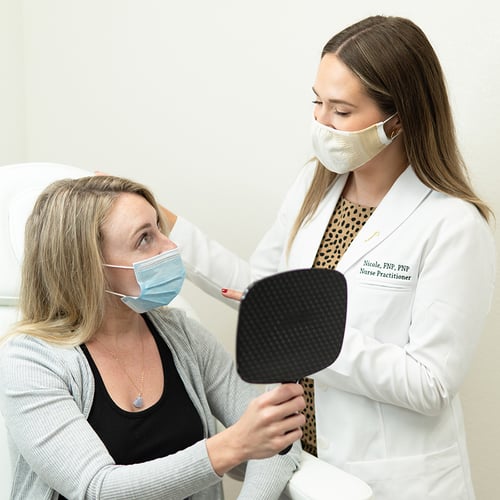Honesty is The Best Policy: Cultivating Authenticity in Your Practice

“I don’t want more than 10u of Botox.”
“Let’s just use one syringe of filler for my whole face.”
“Well, my last injector did it.”
We’ve all been there and know the sense of doom that comes with these kinds of client statements. One of the most difficult aspects of aesthetics is approaching conversations with the client who has unrealistic expectations. Even as an expert injector, it can feel uncomfortable and scary. Learning to navigate, and lead, these uncomfortable encounters has empowered my practice as a provider and helped shape long-term relationships with my clients. Here are my strategies to help establish an environment of trust, safety, and honesty in your practice.
1. Block time for consultations
Every new patient should have a comprehensive evaluation prior to receiving a treatment. Make sure you allot adequate time for this in their appointment. New patients spend anywhere from 15 to 30 minutes with me discussing their medical history, goals, and determining their treatment plan before a needle ever gets involved. While this may seem excessive, you’re actually investing in the trust of your client. This ensures that clients will return to you, and only you, for their treatments. Thorough consultations pay dividends in the long run.
2. Sit down
This is one of the most helpful tips I received in my training as a nurse injector. Nonverbal cues and body language go a long way. Sitting at or below the eye level of the client establishes a safe environment where the power is balanced between patient and provider. I find that my advice and recommendations are better received when my client and I are physically and metaphorically on the same level.
3. Treat every patient like they’re your mom, sister, or best friend
When it comes to the people we love, it is natural for us to be honest; and sometimes brutally so. Clients deserve the same loving honesty about what treatments they do and do not need. It’s natural to fear upsetting your clients, social media backlash, or bad Yelp reviews. This is what gets in the way of aesthetic providers standing firm in their decision to not treat a client. It is possible to be both kind and truthful in how you deliver information to clients. Balancing honesty with tact elevates your practice and gains the respect of your clients. If a client takes offense to your authenticity and transparency, then they aren’t the right client for you.
4. Educate, educate, educate
Explain anatomy, differences between products, and physiology to clients. It’s not above their understanding! It is crucial for them to understand the “why” behind the treatment plan (or the decision to not treat them). Clients come to us for our expertise in knowing what areas require which treatments. The classic example of where education wins is with tear trough filler. Everyone wants to fill their under eyes. We know that, 90% of the time, hollowing under the eyes is due to a lack of support in the cheeks. Filling the tear troughs may temporarily satisfy these clients, but it ignores the anatomical root of the problem. These clients don’t come in wanting cheek filler. But, when they understand the “why”, they’re thrilled with the results for both under eye support and facial balancing. This means taking the time to look in the mirror with them and physically show them what you’re seeing.
5. Safety first
Safety and education go hand in hand. Remember that injectables are medications. The same way you cannot argue the dose of an antibiotic with your doctor, clients cannot argue the dose of Botox or fillers with their injector. Patient preferences and budget should always be a part of the discussion but should not dictate your recommendations. Just like doing too much is unsafe, so is doing too little. When a patient skimps on the recommended number of syringes or units of Botox, they’re most likely going to be disappointed with the results and be upset with you. I find this comes up most often with dosing for wrinkle relaxers. It is completely okay and, in fact, better to recommend a patient put their money towards saving for the optimal, recommended number of units for their face. Under dosing leads to shorter lifespan, more frequent treatments, and, in the worst-case scenario, tolerance to neurotoxins.
Nicole Brustkern
By partnering my practice with Portrait, I have had the opportunity to collaborate with a community of like-minded providers who promote authenticity and integrity in the field of aesthetics. You can find more unfiltered truth on skincare, injectables, and aesthetic medicine on my blog, www.letstoxaboutit.com. You can also find me on Instagram and Tiktok at @letstoxaboutit.


.png?width=352&name=Untitled%20design%20(27).png)